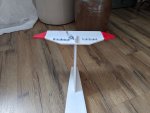Wrench Monkey
Member
After an extremely successful proof of concept with v1 it was time to make improvements based on the initial design's shortcomings. Version two features a shorter tail section and longer nose for ease of balancing (V1 required alot of nose weight). A greatly reenforced empennage featuring a folded v stab with popsicle sticks for spars that pass through the fuselage for extra strength. I also wanted to redesign the h stab to be as small and efficient as possible to save weight at the tail. I added some vortex generators to hopefully increase the effectiveness of the rather small elevator. Finally the overall fuselage is built to be as light as possible in hopes to increase the already impressive flight times I was getting. V2 is using the same wing as V1 as it seems to be a pretty efficient design.
If anyone has tried anything similar I would love to see your designs! I'm always looking for inspiration!
If anyone has tried anything similar I would love to see your designs! I'm always looking for inspiration!
Attachments
-
 received_675925659669529.jpeg135.3 KB · Views: 0
received_675925659669529.jpeg135.3 KB · Views: 0 -
 IMG_20200827_171854.jpg3.8 MB · Views: 0
IMG_20200827_171854.jpg3.8 MB · Views: 0 -
 IMG_20200827_171859.jpg4.1 MB · Views: 0
IMG_20200827_171859.jpg4.1 MB · Views: 0 -
 IMG_20200827_171946.jpg3.6 MB · Views: 0
IMG_20200827_171946.jpg3.6 MB · Views: 0 -
 IMG_20200824_192041.jpg3.8 MB · Views: 0
IMG_20200824_192041.jpg3.8 MB · Views: 0 -
 IMG_20200824_192306.jpg1.6 MB · Views: 0
IMG_20200824_192306.jpg1.6 MB · Views: 0 -
 IMG_20200824_192038.jpg3.1 MB · Views: 0
IMG_20200824_192038.jpg3.1 MB · Views: 0

